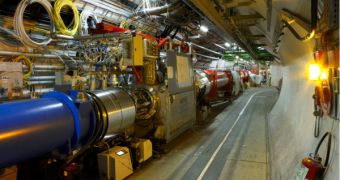According to initial plans, the Large Hadron Collider should have already produced its first scientific results by now. But, as it stands, malfunctions have delayed its operation considerably, and now experts are working around the clock on bringing the largest particle accelerator in the world back online. As repairs progress, a new early warning system is being installed, so that incidents such as the one that disabled the structure do not occur again, the BBC News reports.
The report released by the European Organization for Nuclear Research (CERN), which manages the LHC, shows that last September's leak was caused by a faulty splice between two of the accelerator's superconducting magnets. These elements are used to get particles moving at speeds close to that of light, before they are collided head-on in the largest detectors ever built. Experts hope to be able to observe all known particles ever discovered, in addition to some new ones. The very reason why the LHC was built to such impressive sizes was to be able to detect high-energy particles.
Other accelerators, such as that of Fermilab, may have insufficient energy to detect the elusive Higgs boson, the force carrier that hypothetically allows energy to acquire mass, and turn into a fundamental particle. Additionally, the collisions between the high-speed beams will lead to a deeper understanding of the Big Bang, and the succession of events that led to the creation of our Universe. This knowledge may be closer to use than we think, as the LHC is scheduled to be brought back online this November, and to conduct its first collisions by the end of this year.
Around its 27-kilometer tunnel, quench protection systems that will warn if one or more of the accelerator's 1,200 superconducting magnets overheats are being installed. The engineers hope that such a system will allow them to prevent liquid-helium leaks, such as the one that saw the spilling of a tonne of super-cold liquid in the tunnels last fall. The new system “will allow us to constantly monitor the status of the interconnections. If there is any deterioration detected by the system, the powering of the magnets will be automatically stopped, preventing any damage,” LHC Deputy Head of Hardware Commissioning Gianluigi Arduini explained.
“Last year, we didn't see this thing coming. [With the improvements], we would be looking at downtime of a matter of weeks, rather than a year, we're in a much better place than we were 12 months ago,” the CERN Director of Communications, James Gillies, added.

 14 DAY TRIAL //
14 DAY TRIAL //